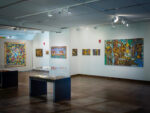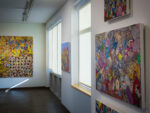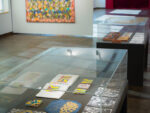Pattern, Accumulation
and the Question of Time
Essay by Michael Lee
Laurie Riccadonna’s paintings at first glance are full of sumptuous color and great detail, exemplary specimens of a master painter’s craft. Both their beauty and craftsmanship, however, are smaller elements of a much larger theme that a casual observer may internalize without consciously noticing. In fact it is something that we humans are all affected by and take great pains to manipulate to no avail: time. You might think time marches unmercifully in one direction. Maybe the poet in you likes to think of it as cyclical. As an artist and thinker Riccadonna has turned these notions over in her head for over two decades, coming up with ways to visualize her relationship to time. In ways both conscious and intuitive, she has sought to represent time as both circular and linear. Like all of us, she knows the human scale of time best, but the artist has attempted to understand it outside of herself to gain a natural and cosmological perspective too. This search for understanding has an unpretentious quality that stems from Laurie’s disarmingly pleasant personality. It allows her work to have an intensity of feeling without seeming exclusionary.
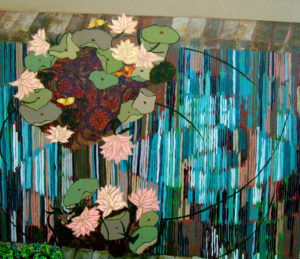 The backbone of Riccadonna’s studio practice is observational drawing. I think it is fair to say that this skill is foundational to every art practice due to the “observing” part more than the “drawing” one. Drawing is simply observing made visible. Painstaking, deliberate observation takes into account so many near-simultaneous decisions about surfaces, structures, and visual organization that to the beginner, a skilled practitioner like Riccadonna can seem more a magician than artist. She has taught drawing for many years and fine-tuned the pedagogy like any good teacher, but she has always been clear with her students that there is no trick to drawing well and no substitute for time spent observing. In a manner of speaking she has trained herself to slow down time and has invited both students and her prospective art audience to do the same. In works as different from one another as Koi from her 2005 Garden series (image 1) and Another Man’s Treasure from her 2019 Plastic Pollution series (image 2) the emphasis is on the specificity of a particular thing (reflections in water in the former and plastic debris in the latter). This attention to detail allows our one sense of vision to migrate towards our sense of touch. An abstraction like time becomes nearly a physical action in our mind. This kind of haptic sensibility informs much of Riccadonna’s work.
The backbone of Riccadonna’s studio practice is observational drawing. I think it is fair to say that this skill is foundational to every art practice due to the “observing” part more than the “drawing” one. Drawing is simply observing made visible. Painstaking, deliberate observation takes into account so many near-simultaneous decisions about surfaces, structures, and visual organization that to the beginner, a skilled practitioner like Riccadonna can seem more a magician than artist. She has taught drawing for many years and fine-tuned the pedagogy like any good teacher, but she has always been clear with her students that there is no trick to drawing well and no substitute for time spent observing. In a manner of speaking she has trained herself to slow down time and has invited both students and her prospective art audience to do the same. In works as different from one another as Koi from her 2005 Garden series (image 1) and Another Man’s Treasure from her 2019 Plastic Pollution series (image 2) the emphasis is on the specificity of a particular thing (reflections in water in the former and plastic debris in the latter). This attention to detail allows our one sense of vision to migrate towards our sense of touch. An abstraction like time becomes nearly a physical action in our mind. This kind of haptic sensibility informs much of Riccadonna’s work.
 Observational drawing. Oil on linen. Still life. This practice, material, and genre place Riccadonna squarely in traditional territory, but I propose that these often rote choices presented in art school were considered and then re-evaluated throughout Riccadonna’s career as the perfect delivery system for this thesis of time. What is observation other than time spent looking well? In Europe oil paint replaced tempera as the preferred medium at the beginning of the fifteenth century chiefly due to its slower drying time and the sensuality of its layered capability. Still life has proven to be a very flexible genre in several different bodies of Riccadonna’s work: as a node in a matrix of pattern, as an individual piece of matter with a history, and as a charged symbol of how we connect to both the visible (natural) and invisible (cosmological) world. Like many artists before her, Riccadonna has figured out a way to make an important, personal connection with her antecedents while also carving out a new path and maintaining a contemporary relevance.
Observational drawing. Oil on linen. Still life. This practice, material, and genre place Riccadonna squarely in traditional territory, but I propose that these often rote choices presented in art school were considered and then re-evaluated throughout Riccadonna’s career as the perfect delivery system for this thesis of time. What is observation other than time spent looking well? In Europe oil paint replaced tempera as the preferred medium at the beginning of the fifteenth century chiefly due to its slower drying time and the sensuality of its layered capability. Still life has proven to be a very flexible genre in several different bodies of Riccadonna’s work: as a node in a matrix of pattern, as an individual piece of matter with a history, and as a charged symbol of how we connect to both the visible (natural) and invisible (cosmological) world. Like many artists before her, Riccadonna has figured out a way to make an important, personal connection with her antecedents while also carving out a new path and maintaining a contemporary relevance.
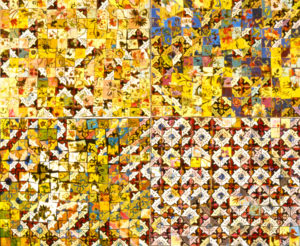 In 2003 Riccadonna was an artist-in-residence at the Valparaiso Foundation in Mojocar, Spain. This afforded her the opportunity to see firsthand some of the wonderful examples of Islamic architecture and ornamentation from hundreds of (and in some cases nearly a thousand) years ago as well as contemporary craft made in the Andalusian region that is still very much inspired from the ancient Arab population. The direct contact with the rural, agricultural surroundings together with the pattern-based aesthetics made a strong impression on the artist. She gleaned the connection between the abstract geometry and the physical world of natural forms she saw. Riccadonna began incorporating more pattern into her work, going so far as to create a body of paintings that paid direct homage to the tile making artisans of the region. From smaller studies that were roughly at a 1:1 scale to the much larger, September (image3), she was combining observational drawing with forms and colors from en plein air sketches to create grids that would expand and contract in different areas of the canvas…breathing geometry.
In 2003 Riccadonna was an artist-in-residence at the Valparaiso Foundation in Mojocar, Spain. This afforded her the opportunity to see firsthand some of the wonderful examples of Islamic architecture and ornamentation from hundreds of (and in some cases nearly a thousand) years ago as well as contemporary craft made in the Andalusian region that is still very much inspired from the ancient Arab population. The direct contact with the rural, agricultural surroundings together with the pattern-based aesthetics made a strong impression on the artist. She gleaned the connection between the abstract geometry and the physical world of natural forms she saw. Riccadonna began incorporating more pattern into her work, going so far as to create a body of paintings that paid direct homage to the tile making artisans of the region. From smaller studies that were roughly at a 1:1 scale to the much larger, September (image3), she was combining observational drawing with forms and colors from en plein air sketches to create grids that would expand and contract in different areas of the canvas…breathing geometry.
The visible world was made to correspond to the world invisible and there
is nothing in this world but is a symbol of something in that other world.
– Abu Hamid Muhammad al-Ghazzali (from the Ihya, 11th c.), in Margaret
Smith, Al-Ghazzali the Mystic, p. 111
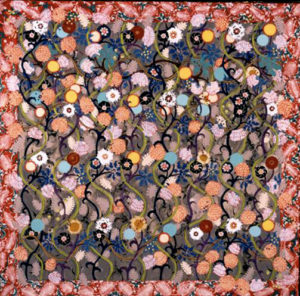 Riccadonna continued working within a grid format in her next Garden series, often tightening up the forms while relegating the grid to an invisible background layer. Garden #1 (image 4) is representative of how the artist used a repetitive floral motif to incredibly dynamic effect. The dual sense of chaos and order is an achievement. In other works that are more closely allied to landscape painting Riccadonna continued using color derived from natural sources but applied flat and shiny, more like French cloisonné than a modeled three-dimensional solid. Throughout examples in the Tiles and Garden series the artist was fusing the tradition of European landscape to another older tradition of abstraction. The loose and luscious expanses don’t pretend to have the crystalline precision or perfect repetition so often remarked upon in Islamic ornamentation, but they attempt to marry her received teachings to her lived experience. In Mojacar, human time, natural time, and cosmic time all met. Unidirectional time was beginning to curve back on itself, placing Riccadonna within nature as opposed to looking at it. The visible world did indeed remark upon and become a symbol for that invisible world of interconnectivity available to anyone willing to seek it.
Riccadonna continued working within a grid format in her next Garden series, often tightening up the forms while relegating the grid to an invisible background layer. Garden #1 (image 4) is representative of how the artist used a repetitive floral motif to incredibly dynamic effect. The dual sense of chaos and order is an achievement. In other works that are more closely allied to landscape painting Riccadonna continued using color derived from natural sources but applied flat and shiny, more like French cloisonné than a modeled three-dimensional solid. Throughout examples in the Tiles and Garden series the artist was fusing the tradition of European landscape to another older tradition of abstraction. The loose and luscious expanses don’t pretend to have the crystalline precision or perfect repetition so often remarked upon in Islamic ornamentation, but they attempt to marry her received teachings to her lived experience. In Mojacar, human time, natural time, and cosmic time all met. Unidirectional time was beginning to curve back on itself, placing Riccadonna within nature as opposed to looking at it. The visible world did indeed remark upon and become a symbol for that invisible world of interconnectivity available to anyone willing to seek it.
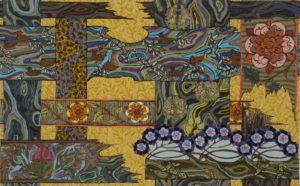 Laurie’s Hanging Garden works found inspiration closer to home as the titles Latitude 44.5 and Silver Lake suggest. Similar to her previous paintings she continued to mine natural phenomena as both subject and symbol. The painting Broken (image 5) is a skillful combination of the two prominent visual themes in Riccadonna’s work of pattern and landscape space. Like many other paintings in the series, what at first appear as autonomous bands of color congeal into stylized grooves in rough cut lumber or the bark of trees or even layers of lichen growing on trunks. The viewer is given over to the fecundity seamlessly intermixing with the decay of the organic world. There is an easy ebb and flow of layers overlapping layers. In other paintings of the same series images of curling leaves, dragonflies, and birds create a sonic presence that gives a nod to Charles Burchfield, one of the great twentieth century painters of transcendent nature. Like the older artist, Riccadonna implies that the accumulation of natural forms inevitably reveals or gives way to the invisible patterns and cycles of life. Again, it is up to us to patiently observe and ascertain their importance.
Laurie’s Hanging Garden works found inspiration closer to home as the titles Latitude 44.5 and Silver Lake suggest. Similar to her previous paintings she continued to mine natural phenomena as both subject and symbol. The painting Broken (image 5) is a skillful combination of the two prominent visual themes in Riccadonna’s work of pattern and landscape space. Like many other paintings in the series, what at first appear as autonomous bands of color congeal into stylized grooves in rough cut lumber or the bark of trees or even layers of lichen growing on trunks. The viewer is given over to the fecundity seamlessly intermixing with the decay of the organic world. There is an easy ebb and flow of layers overlapping layers. In other paintings of the same series images of curling leaves, dragonflies, and birds create a sonic presence that gives a nod to Charles Burchfield, one of the great twentieth century painters of transcendent nature. Like the older artist, Riccadonna implies that the accumulation of natural forms inevitably reveals or gives way to the invisible patterns and cycles of life. Again, it is up to us to patiently observe and ascertain their importance.
The Hanging Garden series also makes a concerted effort to link human time and activity to the cyclical activity of natural actors. Vacationing and spending time with one’s family, seasonal change, bird migration, and the weathering of man-made trellis work —alluded to in both titles and images in the paintings themselves—all point to how these elements large and small play off one another. A greater emphasis on this concept of shared time marks a period of transition in Riccadonna’s life from artist/teacher to mother/artist/ teacher.
In 2014 Riccadonna began work on her Puzzle series, taking inspiration from both the eponymous pastime and a particular kind of European still life known as the vanitas image. The vanitas provided an excellent link between the spiritual, natural, and human worlds in that a painting classified as such attempted to moralize through virtuoso paint handling of natural objects and phenomena. While some artists presented a realistic tableau of blatantly symbolic objects like hourglasses, snuffed candles, and human skulls to remind the pious Christian viewer of their fleeting physical existence, others chose to populate their canvases exclusively with plants, flowers, and fruit. Two of the most well known Baroque flower painters, Clara Peeters and Rachel Ruysch, gave you the bitter pill with a touch of sugar. Naturally these were cut and arranged flowers—not wild in a garden. Youthful buds and mature, bursting blooms commingled with ones beginning to wither. Sure, you had to be on the lookout for the dying stuff, but it was there. A plump, freshly cut pear might share counter space with a peach that had succumbed to rot or a hungry worm. There is no youth without age, no beauty without ugliness. First and foremost, however, came that unbelievable vibrancy and detail. The sermonizing was kept at a whisper.
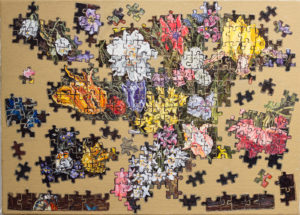 As she has done before with the Garden and Hanging Garden series, Riccadonna overwhelms with information in her Puzzle paintings, depicting not just representations of the Old Masters’ works but their works as store-bought puzzles. The casual, seemingly random compositions of puzzles in mid-completion conceal a serious intention. One needn’t look long to see the density of color and line come from an enormous amount of time-consuming labor. Unlike some of her earlier works these images are a single layer with none of the overlapping of forms, yet they appear in some ways more complex due to the pronounced jigsaw lines and blank spaces that prevent the gestalt a viewer craves, as in Bouquet with Iris (see image 6). Those familiar with the vanitas source material may come to the conclusion that Riccadonna’s images are another kind of symbol: the act of contemplation itself. She has said that the works are “impossible puzzles; the endeavor of bringing order to chaos is never fully realized.”
As she has done before with the Garden and Hanging Garden series, Riccadonna overwhelms with information in her Puzzle paintings, depicting not just representations of the Old Masters’ works but their works as store-bought puzzles. The casual, seemingly random compositions of puzzles in mid-completion conceal a serious intention. One needn’t look long to see the density of color and line come from an enormous amount of time-consuming labor. Unlike some of her earlier works these images are a single layer with none of the overlapping of forms, yet they appear in some ways more complex due to the pronounced jigsaw lines and blank spaces that prevent the gestalt a viewer craves, as in Bouquet with Iris (see image 6). Those familiar with the vanitas source material may come to the conclusion that Riccadonna’s images are another kind of symbol: the act of contemplation itself. She has said that the works are “impossible puzzles; the endeavor of bringing order to chaos is never fully realized.”
These puzzle paintings put me in the same frame of mind as the ornately illuminated Qur’an and Christian gospel pages I have seen, as well as the floor labyrinths of medieval Christian churches and intricate webs of ornament in the mosques of the Iberian Peninsula. All are maps or diagrams of faith (or philosophy if you like) with no readymade key or legend. Their complexity is an invitation to remain simultaneously in the present moment—following line after line—yet also be aware of the infinite number of present moments.
In her most recent Plastic Pollution series Riccadonna has given us her most caustic images of the human relationship to the environment to date. Pictured in these works is the unending accumulation of man-made plastic toys, containers, gadgets, tools—things that are aimed at the modern consumer (read: human time) with very little thought to the adverse environmental hazards they pose. Scientists have noted that every bit of plastic ever produced is still with us, incapable of breaking down fully and disappearing into the chain of life forms. It would seem to be eternal. If we look at Another Man’s Treasure again (image 2), we see a chaotic array of candy colored objects whose accretion provides no hint of the cosmic matrix or geometric pattern of a complex yet rational world. Like a coral reef in reverse, this “bloom” of trash will act in many ways just like a living organism, interacting with the other living things around it, chiefly by leeching poisonous compounds into the shared environs.
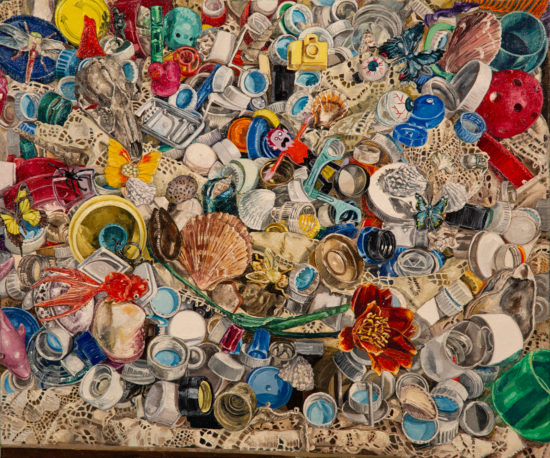 So why make these images beautiful? Part of the reason, I believe, is to pull a viewer in for a closer look. The other part is bound up in love and memory. There is poignancy in knowing the artist’s connection to some of this trash, as her children’s toys (the grimacing rubber man in the Self-portrait as Ophelia, image 7) are presented on the heap. Adored for a time then discarded—like all children’s toys—they can symbolize both the innocence and experience that characterize any child’s growing up. I can think of no better reason to lovingly depict an object. We are all temporary stewards of this earth that we then leave to future generations. As contemporary vanitas images, these works are an extended meditation on hubris and human fallibility. Unlike her Baroque forebears’ efforts these works are also a provocation—a call to action.
So why make these images beautiful? Part of the reason, I believe, is to pull a viewer in for a closer look. The other part is bound up in love and memory. There is poignancy in knowing the artist’s connection to some of this trash, as her children’s toys (the grimacing rubber man in the Self-portrait as Ophelia, image 7) are presented on the heap. Adored for a time then discarded—like all children’s toys—they can symbolize both the innocence and experience that characterize any child’s growing up. I can think of no better reason to lovingly depict an object. We are all temporary stewards of this earth that we then leave to future generations. As contemporary vanitas images, these works are an extended meditation on hubris and human fallibility. Unlike her Baroque forebears’ efforts these works are also a provocation—a call to action.
On the occasion of this retrospective of Laurie Riccadonna’s work, we are given a privileged vantage point that allows us to see paintings and drawings from different times in the same space. This compression of time is a special opportunity that is easy to take for granted. We get to see connections immediately that the artist worked through many years of observing the world as well as her own methods to achieve. I hope that anyone lucky enough to see this exhibition comes away from it with a renewed appreciation for time as both something exceedingly vast and infinitesimally small. Somewhere in the middle stands each of us, perhaps contemplating the way in which we are connected to everyone and everything else.
IMAGE INFORMATION (all images courtesy of Laurie Riccadonna)
Image 1, Koi, 2005, oil on canvas, 57 x 84 inches
Image 2, Another Man’s Treasure, 2019, oil on canvas, 31 x 42 inches
Image 3, September, 1999, oil on canvas 72 x 84 inches
Image 4, Garden Number 1, 2004, oil on canvas, 72 x 72 inches
Image 5, Broken, 2008, oil on canvas, 15 x 25 inches
Image 6, Bouquet with Iris, 2018, oil on canvas, 11.5 x 16.5 inches
Image 7, Self-portrait as Ophelia, 2019, oil on canvas, 20 x 24 inches
END NOTES
1. Smith, Margaret. Al-Ghazali, the Mystic, London: Luzac and Company, 1944

